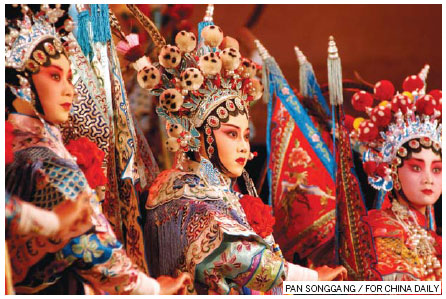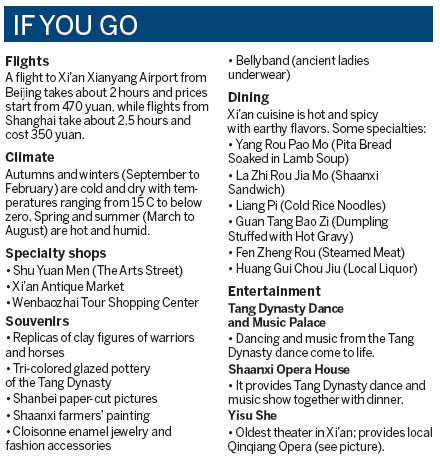Xi'an - more than just clay soldiers
Updated: 2010-12-03 11:15
By Liu Lu (China Daily European Weekly)
 |
|
Qinqiang Opera is a special attraction in Xi'an. [Photo/China Daily] |
Xi'an is a must-see city on any China travel itinerary and here are five of its top tourist sites.
1. Museum of the Terracotta Army
The unearthed Terracotta Warriors and Horses are one of the most significant archeological discoveries of the 20th century and the 2,200-year-old tomb for China's first emperor is the city's jaw-dropping feature attraction. More than 8,000 life-like clay warriors and horses, and 10,000 bronze weapons have been found in the pits and the museum is like a treasure trove of the Qin Dynasty's military affairs, science and technology, art and culture. But experts say they only represent a fraction of what lies beneath. UNESCO listed the burial ground as a World Heritage Site in 1979 and Chinese archeologists continue to search for more of the emperor's soldiers.
2. Big Wild Goose Pagoda
This masterpiece of ancient Buddhist architecture is located in southern Xi'an and is the oldest and highest wooden structure in China. It was built in 652 AD during the Tang Dynasty and is regarded by some as the best pagoda of its kind in the world. The cone-shaped structure was built without the use of nails, but instead with special interlocking layers. This attraction can be divided into three parts: the Big Wild Goose Pagoda, the Da Ci'en Temple, and the North Square of Big Wild Goose Pagoda.
3. Bell Tower
The 36-meter-high Bell Tower is the symbol of Xi'an and marks the geographical center of the ancient capital. It is a classical wooden building with carved beams, painted rafters and is the largest and best preserved of its kind in China. The engravings on the doors of the Tower reflect the decorative fashion of Ming and Qing dynasties, recounting popular historical stories. In ancient times, the bell sounded in the morning while a drum sounded at dusk.
4. Huaqing Pool
It gets cold in northern China so this 40 C natural hot spring became a favorite spa for emperors wanting to keep away the chill. Emperor Xuanzong in the Tang Dynasty used to spend winters in the company of Yang Guifei (Lady Yang) - his favorite concubine - at this cozy location. Today, visitors can bathe like a king and the pools have also earned a reputation for "healing" certain ailments. The pool is located at the foot of Lishan Mountain, about 35 kilometers east of Xi'an city.
5. Banpo Musuem
This was China's first museum established at a prehistoric site and shows a typical Neolithic matriarchal community, which lived in the Yellow River Valley about 6,000 year ago. The remains and artifacts are of paramount archaeological importance for the study of the primitive society in China. The museum is built on the outskirts of Xi'an.

E-paper

Ear We Go
China and the world set to embrace the merciful, peaceful year of rabbit
Preview of the coming issue
Carrefour finds the going tough in China
Maid to Order
Specials

Mysteries written in blood
Historical records and Caucasian features of locals suggest link with Roman Empire.

Winning Charm
Coastal Yantai banks on little things that matter to grow

New rules to hit property market
The State Council launched a new round of measures to rein in property prices.
